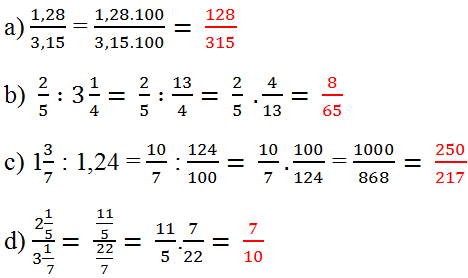Hãy nhập câu hỏi của bạn vào đây, nếu là tài khoản VIP, bạn sẽ được ưu tiên trả lời.

Ta có:5/20>5/25
5/21>5/25
5/22>5/25
5/23>5/25
5/24>5/25
=>S=5/20+5/21+5/22+5/23+5/24>5/25+5/25+5/25+5/25+5/25=1
=>5/20+5/21+5/22+5/23+5/24>1
DỄ
DO: 5/20 <1
5/21<1
5/22<1
5/23<1
5/24<1
=> 5/20+5/21+5/22+5/23+5/24<1
hay S<1 ( ĐPCM)
ĐÚNG NÈ ỦNG HỘ

\(B=\left(\frac{151515}{161616}+\frac{17^9}{17^{10}}\right)-\left(\frac{1500}{1600}-\frac{176}{187}\right)\)
\(B=\left(\frac{15}{16}+\frac{1}{17}\right)-\left(\frac{15}{16}-\frac{16}{17}\right)\)
\(B=\frac{15}{16}+\frac{1}{17}-\frac{15}{16}+\frac{16}{17}\)
\(B=\left(\frac{15}{16}-\frac{15}{16}\right)+\left(\frac{1}{17}+\frac{16}{17}\right)\)
\(B=0+1=1\)
Vậy: B=1

Đặt \(\dfrac{a}{b}=\dfrac{c}{b}=k\)
\(\Rightarrow a=c.k;c=b.k\)
Suy ra:
\(\dfrac{a^2+c^2}{b^2+c^2}=\dfrac{\left(c.k\right)^2+\left(b.k\right)^2}{b^2+\left(b.k\right)^2}=\dfrac{k^2.\left(c^2+b^2\right)}{b^2.\left(k^2+1\right)}\)
\(=\dfrac{k^2.\left[\left(b.k\right)^2+b^2\right]}{b^2.\left(k^2+1\right)}=\dfrac{k^2.\left[b^2.\left(k^2+1\right)\right]}{b^2.\left(k^2+1\right)}=k^2\) (1)
\(\dfrac{a}{b}=\dfrac{c.k}{b}=\dfrac{b.k^2}{b}=k^2\) (2)
Từ (1) và (2) \(\Rightarrow\dfrac{a^2+c^2}{b^2+c^2}=\dfrac{a}{b}\)
Chúc học tốt!!![]()

Viết các phân số sau dưới dạng số thập phân và đúng kí hiệu %:
725,194,2665725,194,2665
Hướng dẫn làm bài:
725=0,28=28%725=0,28=28%
194=4,75=475%194=4,75=475%

Bài 1:
a) \(\dfrac{x^2}{6}=\dfrac{24}{25}\)
\(\Leftrightarrow x^2.25=6.24\)
\(\Leftrightarrow x^2.25=144\)
\(\Leftrightarrow x^2=144:25\)
\(\Leftrightarrow x^2=5,76\)
\(\Leftrightarrow x=2,4\)
b) \(\dfrac{x-1}{x+5}=\dfrac{6}{7}\)
\(\Leftrightarrow7\left(x-1\right)=6\left(x+5\right)\)
\(\Leftrightarrow7x-7=6x+30\)
\(\Leftrightarrow7x=6x+30+7\)
\(\Leftrightarrow7x=6x+37\)
\(\Leftrightarrow7x-6x=37\)
\(\Leftrightarrow x=37\)
c) \(\dfrac{x-2}{x-1}=\dfrac{x+4}{x+7}\)
\(\Leftrightarrow\left(x-2\right)\left(x+7\right)=\left(x+4\right)\left(x-1\right)\)
\(\Leftrightarrow\left(x-2\right).x+\left(x-2\right).7=\left(x+4\right).x-\left(x+4\right)\)
\(\Leftrightarrow x^2-2x+7x-14=x^2+4x-x-4\)
\(\Leftrightarrow x^2+5x-14=x^2+3x-4\)
\(\Leftrightarrow x^2+5x-14+4-3x-x^2=0\)
\(\Leftrightarrow\left(x^2-x^2\right)+\left(5x-3x\right)-\left(14-4\right)=0\)
\(\Leftrightarrow2x-10=0\)
\(\Leftrightarrow2x=10\)
\(\Leftrightarrow x=10:2=5\)
Bài 2:
\(\dfrac{x}{7}=\dfrac{y}{13}\) và \(x+y=40\)
Ta có: \(\dfrac{x}{7}=\dfrac{y}{13}=\dfrac{x+y}{7+13}=\dfrac{40}{20}=2\)
Do đó \(\left\{{}\begin{matrix}\dfrac{x}{7}=2\Rightarrow x=14\\\dfrac{y}{13}=2\Rightarrow y=26\end{matrix}\right.\)
Vậy \(x=14;y=26\)
